 |
 |
 |
 |
 |
 |
 |
 |
 |
 |
 |
 |
 |
 |
 |
 |
 |
 |
 |
 |
 |
 |
 |
 |
 |
 |
 |
 |
 |
 |
 |
 |
 |
 |
 |
 |
 |
 |
 |
 |
 |
 |
 |
 |
 |
 |
 |
 |
 |
 |
 |
 |
 |
 |
 |
 |
 |
 |
 |
 |
 |
 |
 |
 |
 |
 |
 |
 |
 |
 |
 |
 |
 |
 |
 |
 |
 |
 |
 |
|
|
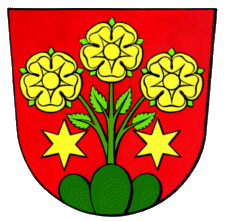 |
|
|
 |
|
|
|
|
 |
|
|
|
|
|
|
|
Strickler Families of the World |
|
|
|
|
|
|
 |
|
|
 |
|
 |
|
 |
|
|
|
|
|
|
|
|
|
|
Coats of Arms |
|
|
|
|
|
|
|
|
|
|
|
|
|
|
 |
|
|
|
|
|
|
 |
|
|
|
Heraldry has always been important to Swiss families and the Strickler family is no exception. Although it is not known when the Stricklers first received a coat of arms. Earliest known records of coats for the family date to the1500�s but it is conceivable that the family had received or adopted a coat generations beforehand. There exist a number of Strickler coats of arms, which over time have been handed down, however, most often their sources cannot be accurately traced. It might be noteworthy to mention that only one symbol, a green triune, is the only symbol to appear on all the Swiss Strickler coats. So it might be surmised that the green triune was one of the original symbols of the family. It might also be noteworthy to mention that no official motto has been found in the records of Switzerland. Several Strickler lines in America have adopted unofficial mottos. The two most common mottos I have seen are �We live to serve (Vivemus Servare)� and �By God�s Grace.� The origins of the later appear to be from a Pennsylvania branch of the family. The former was adopted uniformly by the Strickler families of Augusta County, Virginia.
Following are the most common Strickler coats found today. There are slight variations on each of these coats. Several coats belong to lines of Stricklers that appear to be extinct. Several other coats are of recent origins. The genealogical publishing company known as Halbert�s has misidentified at least one coat as a Strickler coat of arms. |
|
|
|
|
|
|
|
International Strickler Coat of Arms |
|
|
|
|
|
|
|
Adopted in July 2000 this coat was created to represent all the Strickler families of the world. Traditional elements of what are believed to be the oldest coats have been combined to create a coat that all lines of the family can identify with. Mounted on a red background are three golden roses, their stems projecting upward from a green triune heraldic symbol. The green triune is the only symbol present on all older Strickler coats and therefore it might be assumed this was one of the original symbols of the family. Beside the rose stems are two golden stars For the new coat of arms included are three roses, which two branches of the Strickler family have previously employed in their shields. The color selection stems from the two colors used for the shield of the city of Richterswil, the birth land of our antecedent name �am Strick�. The two golden stars add to the shield�s heraldic authenticity, having been used in various Strickler family coats of arms in the Canton of Schwyz. The use of chords or ropes has been eliminated from this design because the use of the chord or rope is a clear misrepresentation of the name Strickler. This new Strickler coat of arms should serve well for all of the branches of the family whose traces lead back to that ancient pathway, �am Strick� in the hills just above the town of Richterswil. Created by Anton Christen, Zurich, July 2000. |
|
|
|
|
Adopted July 2002 |
|
|
|
|
|
|
|
|
|
 |
|
|
|
|
|
|
|
|
|
|
|
 |
|
|
|
|
|
|
Strickler Coats Over the Centuries |
|
|
|
|
|
|
|
United States Coat of Arms & Official Swiss Coat |
|
|
|
|
|
|
|
The librarian of Z�rich sent the coat of arms most often associated with and adopted by the American Strickler families to Harry Strickler of America in 1910. In 1924 Harry subsequently published his book Forerunners that included this family crest. The librarian copied the coat from the book Wappen der loblichen Burgerschaft in Z�rich 1844, by Jacob Kull. Further details were obtained from Siebmachers Wappenbuch, Band V, located in the library of Bern. In 1815 this coat was registered and adopted in the city of Z�rich for a family of Stricklers who that year moved there from Hombrechtikon. The Strickler families of Hombrechtikon, by in large, had migrated there the area of Hirzel or from Richterswil where they had originally settled in 1384 under the surname �am Strick� and had then spread out through the area. The shield can also be found on the coats of arms display wall of the city of Z�rich, in the Jean Eglis Book of Coats of Arms written in 1860 and in the 1992 book, Lexicon of Coats of Arms, by Ottfried Neubecker found in a display at the Battenberg publishing house in Augsburg, Germany. In the first decade of the twentieth century the archives of Zurich accepted this shield as the official Strickler coat of arms. The symbols of the shield are interpreted as Christian ones, and the rose was deigned to symbolize immortality. It is not at all improbable that the family shield did in fact have a Christian significance. The three roses with three stems positioned above three hills, the green triune symbol (3 x 3), could very conceivably symbolize the Trinity. The absence of a helmet, which is usually found on family coats of arms, could certainly be read as a refutation of affection for battle. The person bears a rose instead of a sword: immortality rather than death and peace in lieu of war. At least this is a comforting interpretation, if not the original one.No official motto has been traced to Switzerland. In America several lines of the family, including that which sprung from Augusta County, Virginia, have adopted mottos. The Augusta County Family uses the motto �Vivemus Servare�, translated �We live to serve.� Another known motto of unknown lineage is �By God�s Grace.� |
|
|
|
|
Adopted before 1685 |
|
|
|
|
|
|
|
|
|
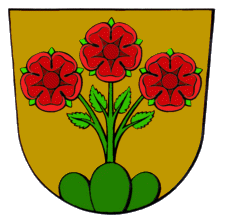 |
|
|
|
|
|
|
|
|
|
Vivemus Servare
We live to serve |
|
|
|
|
|
|
|
|
|
|
|
 |
|
|
|
|
|
|
Stricklers of Langnau am Albis, ZH, SWI |
|
|
|
|
|
|
|
This coat was found on an 1859 coat of arms of a Strickler family which had moved from Langnau am Albis to the city of Z�rich where they were granted citizenship. In 1869 this coat of arms was cited in the historical coat of arms book of Z�rich. The Stricklers of Langnau am Albis migrated there as early as the 1630�s when on 1 December 1630 a Hans Strickler with wife Elsbeth Huber of Thalwil, son Rudolf and daughter Margaretha lived at Striemple in the community of Langnau am Albis. Descendants of that family have been traced thru to the 1950�s.Descriptively the coat was apothecary�s mortar surrounded by two red roses above the green triune symbol, all positioned on a blue background. Presumably the apothecary�s mortar indicated the profession of the head of the household. According to city of Z�rich archives, that branch of the family no longer exists in the city of Z�rich but descendants still populate the outskirts of the city. |
|
|
|
|
Adopted before 1800 |
|
|
|
|
|
|
|
|
|
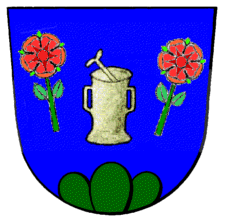 |
|
|
|
|
|
|
|
|
|
|
|
 |
|
|
|
|
|
|
Stricklers of Menzingen-Neuheim, Zug, SWI |
|
|
|
|
|
|
|
Adopted by 1590 |
|
|
|
|
|
This coat of arms is the official coat of arms for the Strickler family in the Canton of Zug. This line of the family moved to Canton Zug as early as 1549. In 1512 a family of Stricklers lived at Chnaeus, near H�tten and on the Sihl River. Deeds of Einsiedeln for 1549 and 1563 show that Hermann Strickler had migrated across the Sihl river and taken up farming at Finstersee (Canton of Zug). It is believed that nearly all Stricklers of the Menzingen-Neuheim area and most of the families in the city of Zug, all descend from this line of Stricklers. Descriptively the coat is a bare rooted golden tree positioned above a green triune symbol, all on a solid blue field. Two stars flank the tree and hearken back to the stars on the family shield of Richterswil (see below). The stars probably represent Sternen (the stars), the Inn the Stricklers ran on the strick by 1470. Details can be found in the Book of Coats of Arms of the Canton of Zug and in Styger�s Book of Coats of Arms of the Canton of Schwyz on page 266 as well as in the book, Menzingen, the Community on the Mountain. The shield can be seen displayed in the church in Neuheim in the Canton of Zug as well as in the community centers and a church in Menzingen. Paul Anton Wickart, a priest and historian of Zug, lists a Strickler having the right of residency in the town of Zug as early as 1590, but he does not provide additional detail. The tree probably represents an Oak tree common to the area of Samtagern where the Strickler family lived and helped maintain the common ground. At Samstagern people would go to gather acorns for feed. |
|
|
|
|
|
|
|
|
 |
|
|
|
|
|
|
|
|
|
Crest in Menzingen |
|
|
|
|
|
|
|
|
|
 |
|
|
|
|
|
|
|
|
|
Crest in Neuheim |
|
|
|
|
|
|
|
|
|
ph. by Frank Duff Aug 2005 |
|
|
|
|
|
|
|
|
|
|
|
 |
|
|
|
|
|
|
Stricklers of Menzingen-Neuheim, Zug, SWI #2 |
|
|
|
|
|
|
|
Adopted after 1590 |
|
|
|
|
|
The image given here to the left is a simpler version of the crest of Menzingen and Neuheim. This image was provided by Karl Strickler and was from what I recall, drawn from the book of Coats of Arms of the Canton Schwyz and also in the book of Coats of Arms for the Canton of Zug. This variation on the Menzingen coat is a more recent coat than the previous images which are also found in the same sources. Apparently some Stricklers in Canton Schwyz also claim this variation of the crest. This crest is also claimed by many of the Strickler family that immigrated to Canada since 1850. |
|
|
|
|
|
|
|
|
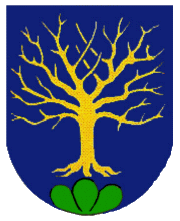 |
|
|
|
|
|
|
|
|
|
|
|
 |
|
|
|
|
|
|
Stricklers of Richterswil, ZH-Wollerau, SH |
|
|
|
|
|
|
|
This shield was taken from Martin Styger�s 1936 Book of Coats of Arms of the Canton of Schwyz. As people of Richterswil in Canton Zurich, the descendants of this particular branch of Stricklers were participants in the right to the common land along with the people of the neighboring farmstead of Wollerau. During the Reformation they had come to the old land of Schwyz and consequently had acquired the right to live there even though they did not have the full rights of citizenship. Per the 1629 Annual Almanac of Richterswil-Wollerau a Hans Strickler owned tract of land identified as the Rohrwiese in Wollerau. With the division of the families on April 26, 1806 this lineage of Stricklers with two citizens over twenty years of age were assigned to the Steinerviertel quarter of the city of Zug. Records of the city of Zug suggest that this line of the family is extinct. However the family may still exist in the regions of Wollerau-Richterswil or in the neighboring areas outside the region of Zug.This coat consists of a divided shield, the upper part has a blue background on which appear two entwined golden loops of rope while the lower part shows two red stars above a green triune symbol on a white field. It may be noted that some descendants in eastern Zug also claim this crest. |
|
|
|
|
Adopted pos by 1520 |
|
|
|
|
|
|
|
|
|
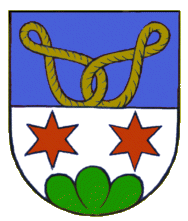 |
|
|
|
|
|
|
|
|
|
|
|
|
Although it is not known just how old this coat of arms is, the elements it contains are perhaps the oldest elements of the Strickler coats. For instance the stars probably represent the Stricklers that settled at Sternen in the 1460's. Sternen meaning the Stars, obviously being represented by stars. The cords, which I suspect have been stylized with time, obviously represent the cordlike road the family lived on from the earliest times. This coat may have begun as the sign placed outside the Sternen for passersby to see. |
|
|
|
|
|
|
 |
|
|
|
|
|
|
Stricklers of Richterswil, ZH-Wollerau, SH #2 |
|
|
|
|
|
|
|
Adopted before 1650 |
|
|
|
|
This coat is nearly identical to the Richterswil-Wollerau-Zug coat of arms. It was presented to Karl Strickler of Edmonton, Canada by his Aunt Paula (Strickler) Kieser. Descriptively the coat is a divided shield, on this one the upper part has a red background upon which appear two entwined loops of silver colored rope, while the lower part displays two golden stars above a green triune symbol on a blue field. Notice the only difference between this and the previous coat is the colors of the shields backgrounds. Thus far, precise information concerning its origin is not known. However the existence of this coat in a line of Stricklers that traces to Canton Zug may suggest the line is still present and not extinct as the records of the city of Zug suggested. |
|
|
|
|
|
|
|
|
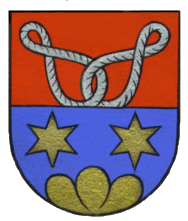 |
|
|
|
|
|
|
|
|
|
|
|
 |
|
|
|
|
|
|
Stricklers of Richterswil, ZH-Wollerau, SH #3 |
|
|
|
|
|
|
|
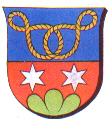 |
|
|
|
|
|
This coat of arms is similar to the two other Richterswil-Wollerau-Zug coats of arms. The different in this coat and the others again is only the coloring of the background and stars. In this case the stars are white and the blue and red halves of the shield are switched. This coat has been passed down in the family of Irma (Strickler) Krause (b. 30 Sep 1921). Again this is further evidence that the family line is probably not extinct as the records of the city of Zug suggest. |
|
|
|
|
|
|
|
|
|
|
 |
|
|
|
|
|
|
Stricklers of Ludwigschafen, R-Pfalz, Germany |
|
|
|
|
|
|
|
This coat of arms was created in the late 1990�s to represent a group of Strickler families that live in the Rhineland town of L�dwigschafen. The families moved there during the 17 and 1800�s coming mostly from the Mennonite Strickler communities in neighboring smaller towns. The coat was commissioned by Juergen Strickler. Symbolically the red dragon is the emblem of the Rhineland. The colors are those official to the Rhineland. The wavy blue-green that divides the shield represents the Rhine River which divides Germany. The red cord and needles are a representation of the German meaning of the word Strickler, which is cord maker or knitter (although this is a clear misrepresentation of the families origins). I do not recall being told the meaning of the two fleur. |
|
|
|
|
Adopted about 1995 |
|
|
|
|
|
|
|
|
|
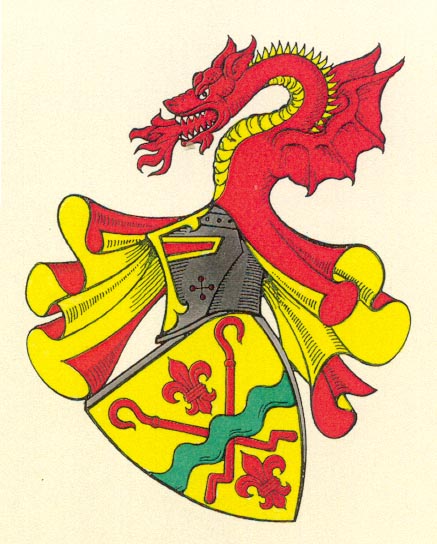 |
|
|
|
|
|
|
|
|
|
|
|
 |
|
|
|
|
|
|
Misidentified as Strickler Coat: Stigler von L�wenberg |
|
|
|
|
|
|
|
Strickler Coat Misidentified: Actually Strigler von L�wenbergIn 1994 Halbert�s Family Heritage published a book entitled �The World Book of Stricklers.� Included in this book was a coat of arms they identified as the official Strickler coat of arms. Their source was given as Riestap Armorial General. When this source was checked it was found that the coat of arms listed in Halbert�s book for the name Strickler actually was the coat of arms for the family Strigler von L�wenberg. When approached about this error the publishers stated they used a variant spelling for Strickler and had concluded that Strigler was the most probable variant of Strickler. They refused to apologize for the error simply stating that names and heraldry are open to interpretation and their publication simply represented their interpretation of the records. They concluded that it was conceivable that at least one Strickler came from the family of Strigler von L�wenberg. |
|
|
|
|
Misidentified in 1994 |
|
|
|
|
|
|
|
|
|
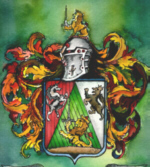 |
|
|
|
|
|
|
|
|
|
illustration Frank Duff 1995 |
|
|
|
|
|
|
|
|
|
|
|
|
|
|
 |
|
|
 |
|
|
|
 |
|
|
|
|
|
|
|
Page last modified 16 November 2005 |
|
|
|
|
|
|
|










